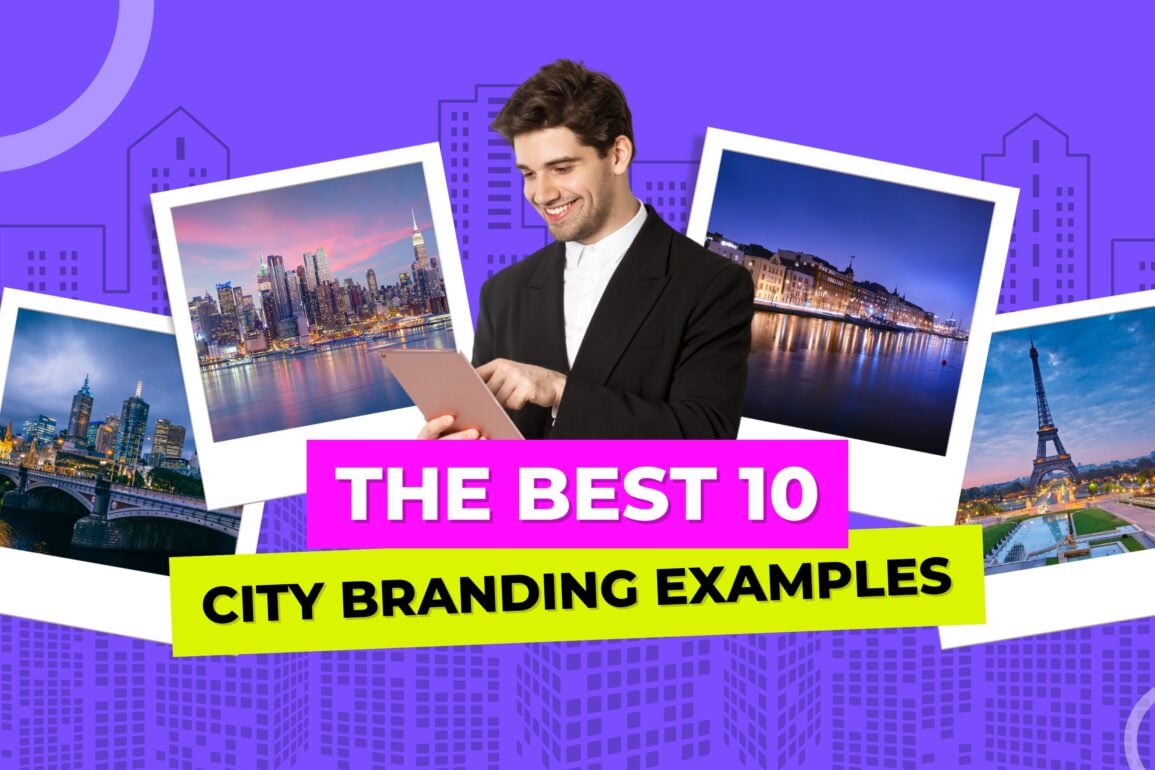Cityscapes of success: The 10 best city branding examples

Think branding is just for companies, employers, and individual people? The best city branding examples prove otherwise. Just like any entity, cities use branding to convey their unique benefits to both citizens and visitors, elevate equity, and form emotional connections.
In recent years, place branding has become increasingly important to ensuring certain towns, countries, and locations can attract the right talent, visitors, and investors. A good city brand strategy can even redefine how entire generations perceive a particular destination.
Just look at how New York drew attention away from rising crime numbers and overpopulation, with the “I love NY” campaign. Of course, building the right brand image for a location isn’t simple.
You sometimes have to walk the line between building a branding campaign that presents your city as “unique” and innovative, while also appealing to a broad audience of potential global visitors.
A good way to get started? Learn from the city brands already established in locations all over the globe.
Here’s your guide to some of the best city branding examples in the world today.

What is city branding? The basics of place branding
City branding is a type of “place branding”, which builds on the idea that a particular place can be infused with a certain image or personality, that connects with human beings on an emotional level.
A city’s brand influences how the location is perceived on a massive scale. Successful campaigns can position a specific region as the perfect place for new students to hone their skills, or as the ideal environments for startups and new businesses to find their footing.
Used correctly, city brands can inspire pride in local citizens, convincing them that their home is a good place to live and work. They also help clarify the city’s identity in the eyes of global governments, potential visitors, and worldwide organizations.
Just like there’s no one-size-fits-all strategy to creating a successful corporate, employer, or personal brand, there’s no single right way to brand a city. The methods used vary depending on the goals of key stakeholders in government groups and location branding teams.
Some decision makers focus on drawing attention to the heritage of a location, highlighting historical buildings, or meaningful moments in history that took place within their streets.
Others focus on demonstrating the potential of the city for future generations, concentrating on a branding and marketing strategy that champions concepts like sustainable development or diversity and inclusion. However, the overall idea behind every city brand is the same.
The goal is to show a large audience that your city isn’t just a collection of buildings and streets, it’s a landscape of incredible potential and opportunity.

Why is city branding important?
So, why is city branding so important?
Simply put, it’s the key to making sure you connect with the right audiences, and unlock new opportunities for a specific location. Just like companies use branding initiatives to attract a specific target audience, and earn their loyalty, government groups can use city branding to the same extent.
As the best city branding examples show us, an effective city brand or “place brand strategy” can help drive economic development.
It can:
Strengthen tourism
The travel and tourism industry plays an important part in any location’s “GDP”, or economic performance. City brands are how you convince potential visitors that your city is the best place to visit.
It’s what convinces an eclectic mix of people to visit your home, invest in your local businesses, and fall in love with the experience you offer.
Just look at Colorado. Though Colorado is a state, not a city, it was previously considered one of the best tourist destinations for skiing and winter sports lovers, but no-one else. A successful branding campaign showed visitors Colorado had something to offer all-year round.
Attract companies and investors
To grow and thrive, small and major cities alike need to attract new entrepreneurs, investors, and companies to their shores. Governments need to convince companies that they can give them a successful place to launch and attract customers, to increase a place’s economic value.
Look at Silicon Valley, in California. Through some successful branding and place marketing, the location is now considered the go-to location for tech startups. Similarly, Tel Aviv overcame its economic issues by investing in a thriving technology sector.
Now, the region has the one of the highest numbers of startups per capita worldwide! More businesses gives cities more way to generate money, and drive future development.
Capture the attention of new talent
A city brand can also be a good way to attract crucial talent to the new companies setting up shop in a specific region. With virtually every industry currently experiencing skill shortages, government groups want to attract highly educated and experienced people to their streets.
The best city branding examples show us that the right “image” for a city can convince people to leave their own homes behind in search of sunnier shores.
With the power of branding, cities can attract talent from the rest of the world, creating more innovative and successful companies, governments, and more. For instance, in 2023, London was named one of the top cities in the world, thanks in part to the opportunities it offers new talent.
Inspire local pride
Most of us know that companies rely on the loyalty of their customers to ensure they remain profitable, and pave the way for continued growth. However, cities rely heavily on loyalty too.
With nationwide advertising campaigns all over the world trying to draw talent, businesses, and investors away from different regions, cities need to fight to retain their citizens. A strong branding strategy can be an excellent way to achieve this.
Effective city brands inspire a true sense of pride in their community, ensuring locals actually want to give back and contribute to the growth of their home city. Just consider how Amsterdam inspires a sense of pride and belonging in its citizens, with the “I Amsterdam” campaign.

10 city branding examples from around the world
The best way to understand the value of destination branding, or city branding, is to look at some examples. Here are some of the best city branding examples we’ve seen over the years, and how they’ve contributed to the growth of various worldwide locations.

1. New York City, USA
When it comes to the best city branding examples in the world, New York City is clearly one of the top contenders. The location’s officials first discovered the value of great city brands back in 1976, when New York was struggling with a poor reputation.
The city was often seen as dangerous, grey, and even dirty, making it hard to attract tourism. The launch of the “I heart NY” campaign changed all that.
The simple message and new visual identity was commissioned by the New York State Department of Economic Development, and created by the iconic Milton Glaser. By 1978, New York had one of the most iconic logos in place branding history.
Tourism began flocking back to the region, and financial challenges dwindled, allowing New York to enjoy an incredible resurgence. Since then, New York has updated its branding a few times, switching from “I heart NY” to “We heart NY”.
New York even updated its entire set of branding guidelines in 2023, with new typography choices, graphic elements, color standards, and more. Now the region seems more modern, diverse, and colorful than ever.

2. Melbourne, Australia
Another of the best city branding examples to take a colorful approach to visual identity, comes from Melbourne Australia. When the city of Melbourne commissioned an agency to create a new logo and brand strategy for the region, the city was struggling with an outdated presence.
The government and tourism sector needed a new, versatile way to attract attention from a range of different groups. They wanted an identity that was simple, but diverse, ready to propel Melbourne into a new era. The resulting “M” logo, created for the location was the perfect solution.
The branding is fresh, energetic, and dynamic, ready to adapt to a range of different environments and marketing strategies. Combined with intelligent marketing efforts, like the “Feel the City” campaign, it helped to redefine Melbourne as a place of creativity and community spirit.
Though Melbourne’s approach to their city brand was relatively simple, it had amazing results, increasing the gross regional product of the region by 6% in just one year.

3. Helsinki, Finland
Back in 2017, the city of Helsinki embarked on an ambitious city brand strategy. Helsinki wanted to be seen as the most “functional” city in the world, appealing to new employees, investors, businesses, and tourists.
The resulting brand strategy, drew insights from 200 people, working in different departments and positions within the city. Over the course of 7 months, the team ran a number of sprint sessions and collected feedback to drive their project forward.
The result was a revitalized visual identity, that replaces the old-fashioned Helsinki crest with a new, modern motif. The branding preserved some of the key aspects of the original Helsinki visual identity, such as the shape of the lower half of the city’s shield.
However, at the same time, it demonstrated a commitment to the future and innovation that helped the location appeal to a much wider audience, boost tourism, and increase local pride.

4. Paris, France
In 2019, the city and department of Paris merged, introducing a new opportunity to revitalize the visual identity and brand of the capital city.
While the branding team chosen for the task were initially tempted to use iconic landmarks in the city’s new logo (like the Eiffel Tower) they eventually took a different approach. The new logo for the city leverages the “Nave”, the ancestral symbol of Paris, composed out of a single line.
New typography was also introduced, which combined with the chosen symbol, gives the city a highly modern and sophisticated appearance. Notably, the team also eventually chose to replace the red, white, and blue associated with Paris with a simple dark blue color palette.
The team of experts at the agency chosen for the task, created a full new set of branding guidelines for Paris, complete with insights into how to use the new logo in a range of marketing campaign ideas and strategies.
The “brand refresh” successfully enhanced the image of the city, allowing Paris to cement their position as a city of culture, passion, history, and innovation.

5. Amsterdam, Netherlands
For decades, Amsterdam has stood as an essential travel destination for anyone exploring the wonders of Europe. However, a problematic period between the 1980s and 2000s saw the city’s position on several international rankings falling for various reasons.
Amsterdam had begun to gain a reputation as a place of sex, drugs, and endless canals. However, the Amsterdam government wanted to highlight just how diverse and incredible the region really was. It needed a brand that would boost economic growth, and inspire a sense of belonging.
Fortunately, the city of Amsterdam launched the “I Amsterdam” campaign, a marketing and rebranding strategy focused on drawing attention to the bestselling points of the city.
The campaign highlighted the incredible historical landmarks, museums, and tourist destinations of the region, with pictures from a collection of renowned photographers. At the same time, the new logo for the city highlighted a sense of local community, and inspired pride among locals.
The results were phenomenal. Amsterdam rose back up in the rankings for one of the best European cities, and tourism numbers increased.

6. Porto, Portugal
In 2014, the city of Porto needed a new brand strategy. The location had struggled until that point to create a consistent image and message that would appeal to both future and existing residents, as well as tourists and investors.
Porto wanted to update its image, to represent itself as a “City for everyone”, where people from all walks of life could enjoy incredible experiences and pursue their passions. Working with an agency, the city created a new visual identity, based on the traditional blue tilework of the region.
Over 70 grid-based geometric icons were developed, all of which can be endlessly combined to create a visual that represents the innovation and complexity of the region.
As one of the best city branding examples on this list, Porto’s rebrand established the city as a place with a focus on the future. The new brand not only appeals to existing community members, by harking back to the region’s history, it also attracts a new audience of younger visitors.

7. Alburquerque, New Mexico
What’s the first thing you see in your mind when you think of Alburquerque? From 2008 to 2013, there’s a good chance it’s the characters of the famous TV show, Breaking Bad. While this iconic series definitely helped put Alburquerque on the map, it didn’t promote the best “brand image”.
The city wanted to position itself as more than just the home of “Walter White”. It hoped to draw attention to the incredible architecture, art, and tourist destinations on offer.
In 2015, city officials refreshed the slogan for the region (previously “It’s a trip”), with the new message “Change your perspective”.
A new logo and visual identity was also introduced, replacing the old-fashioned image of the city with something modern, that retained some of the location’s rich history. The result of the city rebrand was more than just a revitalized image.
Albuquerque discovered its brand could be a powerful tool for driving investment in the public sector, and attracting entrepreneurs from around the world.

8. Copenhagen, Denmark
The “Open Copenhagen” campaign is one of the most interesting city branding examples on this list. The campaign was developed to unify a fragmented series of messages and ideas that spanned the economic development, tourism, and talent recruitment landscapes of the region.
Copenhagen’s city officials wanted a memorable way to share the value proposition of the capital city with tourists and locals alike. The result was a strategy that combined traditional marketing assets, such as signage and video ads, with the production of a series of buttons.
These buttons, which drew attention to the word “Open” the name “Copenhagen” reminded visitors and people all over the world that the region was “Open” to change, development, and innovation.
It highlighted what made Copenhagen such an interesting place, committed to community spirit, diversity, and inclusion. Plus, since people could actually buy and wear the “Open” buttons, it offered the city a great way to get citizens involved in its rebranding strategy.

9. Hong Kong, China
The city officials of Hong Kong, in China, have been experimenting with building the ultimate city brand for years. Back in 2015, the region hosted one of its most successful branding initiatives, with the “Our Hong Kong” campaign.
The campaign was crafted to draw attention to the strengths of the region, from its unique collection of innovative tourist attractions, to the incredible opportunities offered to entrepreneurs, investors, and visitors.
It also communicated a sense of collective pride, leveraging real-life stories about locals.
The campaign combined emotional messages from citizens, with beautiful photography from across the location. Since then, Hong Kong has continued to build on its brand strategy with a host of new initiatives.
In 2021, they created a new strapline: “Hong Kong: A world of opportunities”.
Later, in 2023, Hong Kong’s tourism board created the “Hello Hong Kong” campaign, with a new city logo and a marketing strategy that involved distributing free airline tickets to visitors.
The new logo made Hong Kong seem more fun and exciting, particularly to younger audiences, with its unique font choice and bright coloring.
The result of the latest campaign was an increase in tourism, as well as a significant boost to the overall “brand awareness” for the city.

10. Edmonton, Canada
In 2012, the leaders of the academic, arts, public service and business communities in Edmonton, Canada joined forces to create an economic development plan for the future of the region. The number one problem they needed to overcome was a poor image and reputation.
Although local citizens loved the city, many other people worldwide saw it as cold, boring, and remote. The group decided to revitalize its image, with a branding and marketing strategy that showed the city as a place with a “Story to tell”.
The team working on the project interviewed countless people from around Edmonton, including business leaders and officials, for insights into what made the location special.
They discovered the region was a place of creativity and innovation, with a thriving community. To begin building the Edmonton brand, the city asked citizens to share their experiences of the city with them, and get involved with fun campaigns.
People put lights on the city’s iconic High Level Bridge, launched mural campaigns, and created community gardens, developing plenty of marketing materials to draw attention to the region.
The result was the creation of a collaborative brand story, that highlights Edmonton as a place where people can achieve anything.
Building an effective city brand
While there are plenty of excellent city branding examples out there in the world today, it’s worth remembering that an amazing “city brand” takes a lot of work to establish. Designing a strong and resilient identity that appeals to so many different groups and communities takes a lot of work.
If you want to attract potential investors and tourists, convince locals that your small city is the best place to call home, and drive economic development, you need a comprehensive strategy.
The examples of city brands mentioned above were successful for a few reasons. First, the branding teams and city officials behind the projects had a clear vision or goal for what they wanted to achieve.
They knew what kind of people they wanted to reach with their branding, and had a clear vision of the unique value propositions that would enhance their city’s image.
Secondly, they took a comprehensive approach to the branding process. They didn’t just build a brand by creating a city logo. Each new brand identity built above combined visuals, with personality, messaging, and impactful campaigns.
Finally, all of the city branding examples mentioned above have remained agile and dynamic. As cities continue to evolve, city officials know their brand identity needs to transform with them.
If you’re inspired by the city brands mentioned above, reach out to Fabrik today to learn more about building a brand that breaks down borders, and drives genuine results.
Fabrik: A branding agency for our times.
















